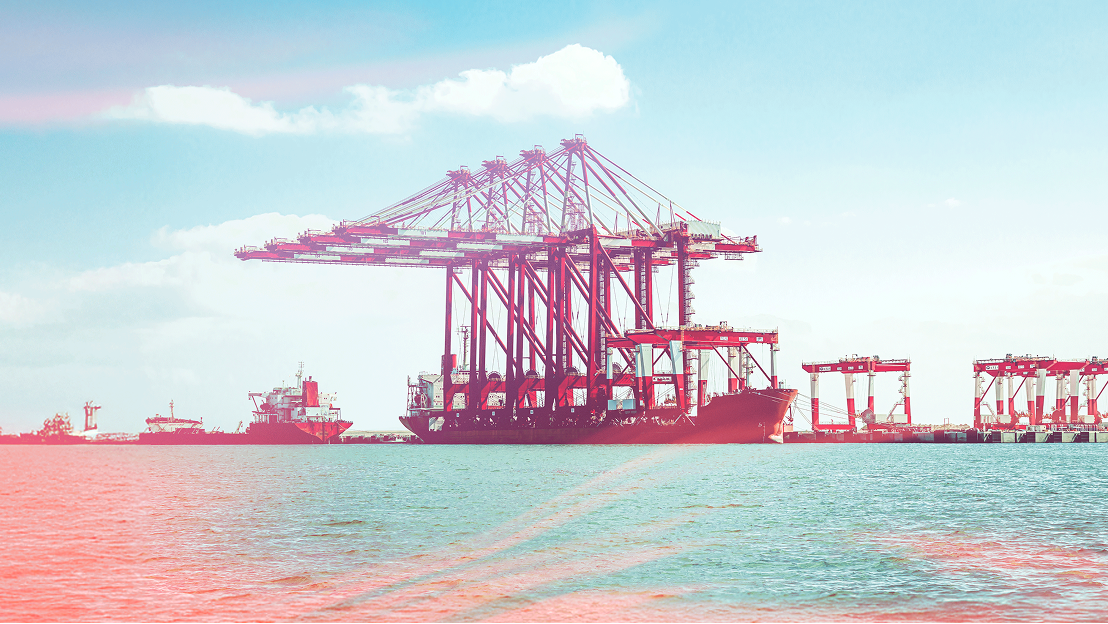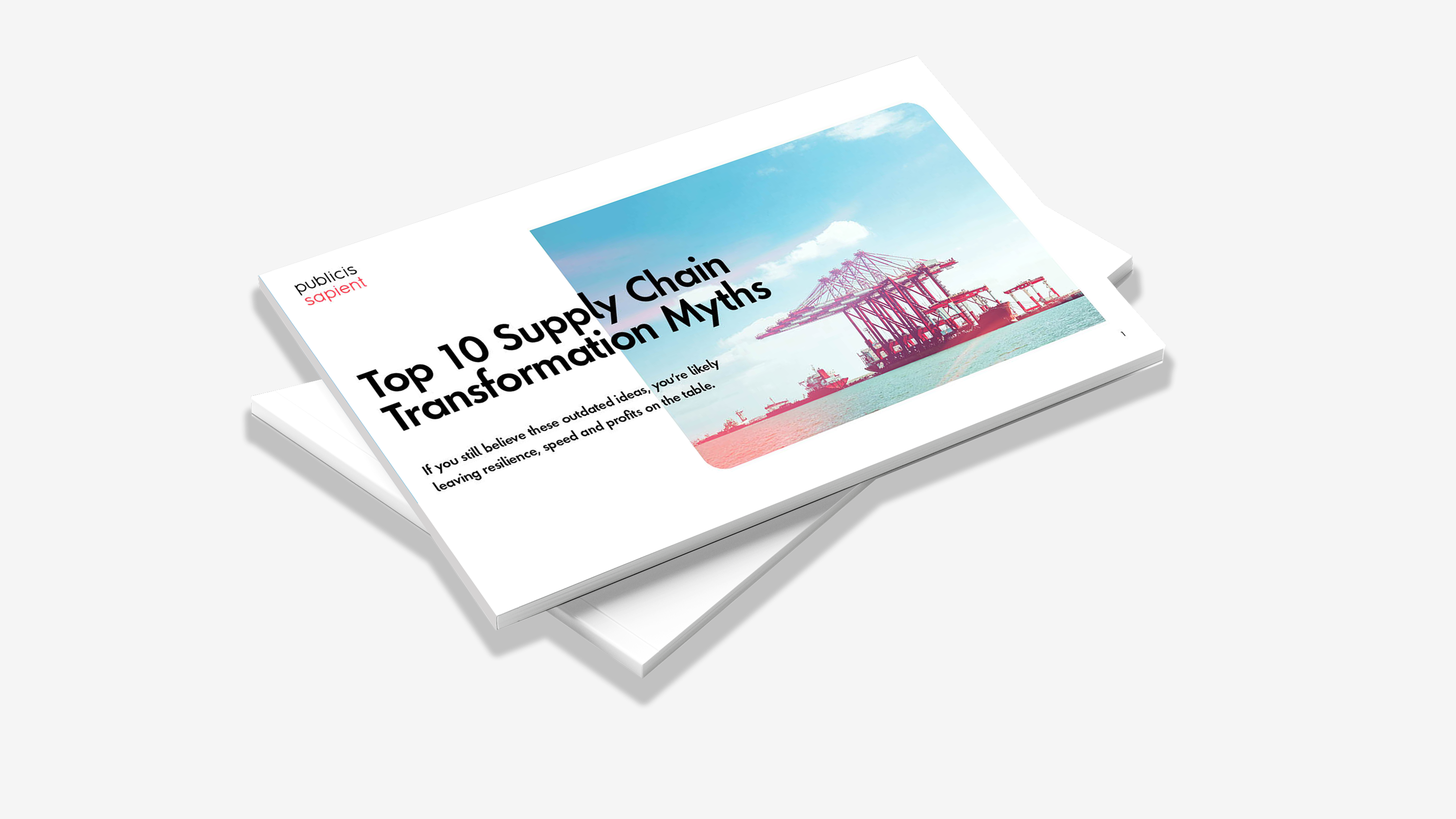What issue can we solve for you?
Type in your prompt above or try one of these suggestions
Suggested Prompt


Top 10 Supply Chain Transformation Myths
If you still believe these outdated ideas, you’re likely leaving resilience, speed and profits on the table.


Introduction
Eighty-one percent of supply chain executives say transformation is their top priority, and 79 percent of organizations are increasing investments. But transformation requires more than urgency and money. It takes clarity, coordination and the courage to challenge common myths that keep organizations stuck in reactive, outdated patterns.
These are the top 10 pervasive myths we’ve encountered across decades of conversations with supply chain executives, and the reality that’s on the other side.
Myth 1: We’re past the COVID-19 hangover
Reality: Things will never be the same
It’s tempting to believe the worst is behind us. The crisis phase of the pandemic has faded, global shipping congestion has improved and supply metrics have stabilized. But those signals can create a false sense of security.
COVID-19 exposed systemic weaknesses—like brittle supplier networks and limited buffer inventory—that still persist. Many companies applied stopgap measures at the time, but few addressed the root causes of disruption. Now, we all face a new normal where volatility is persistent. Whether it’s wildfires in Canada disrupting rail transport or a cyberattack halting port operations, these continued unexpected events can have cascading impacts.
What’s needed is not a return to pre-COVID models, but a reinvention to accommodate future crises. This includes strengthening supplier diversity, reducing overreliance on single geographies, building dynamic safety stock strategies and embedding contingency planning into demand forecasting.
This supports you in shifting from reactive survival mode to building resilience as a core competency.
Myth 2: Transformation is a tech initiative
Reality: It’s an operating model overhaul
Executives often anchor transformation in a tech roadmap—new ERPs, warehouse automation, advanced analytics. But this mindset misplaces the foundation. Technology enables transformation; it doesn’t drive it.
Without rethinking roles, decision rights, data governance and collaboration models, new systems replicate the same inefficiencies. It’s like upgrading the hardware without updating the software.
Micron’s story highlights this. By aligning business processes before introducing new systems, they created an environment where new technology could flourish. Planning became faster. Communication improved. Organizational silos started breaking down.
Transformation starts with questions: Who makes decisions? How do they get the data they need? What’s blocking execution? By starting with these questions, then examining the operating model to understand which processes to re-design and refine, this enables the technology to amplify the end impact, rather than compensating for misalignment.
Discover how Micron reimagined its global supply chain to thrive amid disruption.
Read the full case study to see how Micron shifted from a push-based model to a responsive, digitally enabled supply chain.
Myth 3: I only need tech partners
Reality: Transformation is a larger team sport
When supply chain initiatives stall, technology partners are rarely the root cause. The real issue is often organizational: fragmented priorities, siloed teams and a lack of alignment across planning, procurement, finance, IT and operations. True transformation doesn’t happen in isolation—it requires cross-functional coordination and a shared commitment to new ways of working.
At Merit Medical, a supply chain planning implementation became a broader exercise in organizational change. The company was rolling out Blue Yonder software, but the success of the project hinged on more than Blue Yonder itself. The cross-functional collaboration had to be built from the ground up. Leadership alignment, clear communication across departments and day-to-day process changes were just as important as the system configuration.
What helped the transformation succeed was not just a technical deployment, but a deliberate effort to embed new behaviors and expectations across teams. Change management was integrated from the start—not treated as a final step. Executive sponsors were engaged early. Functional leaders were part of the design. And frontline teams were supported as they adapted to new planning processes.
This case illustrates a simple truth: The best technology can't deliver lasting value unless people across the organization are empowered to use it, adapt with it and collaborate around it. Digital business transformation isn’t just a product decision. It’s a people decision.
Learn more about Merit Medical’s supply chain transformation
Myth 4: No one gets our supply chain like we do
Reality: You can learn from other industries
It’s easy to believe your supply chain is too unique, too complex, too nuanced to borrow best practices from others. But that belief can turn into a blind spot.
High-performing supply chains are shaped by looking outside their own industries. Retailers have adopted manufacturing principles like Lean and Six Sigma, concepts from the automotive and electronics industries. Automotive firms have adopted customer experience best practices from e-commerce, and many other industries are following suit.
Learning from peers outside your industry garners results, even when it comes to the most complex of supply chains. For instance, a global energy company struggling with last-mile visibility could benefit greatly from lessons learned in consumer products distribution. By layering geospatial data with dynamic routing logic borrowed from grocery delivery, the company could drastically improve lead times. The innovation edge often lies in your willingness to look beyond your category.
Myth 5: My people hate training
Reality: They’re hungry for knowledge
Many supply chain professionals entered the field through apprenticeship, not academia. Their expertise is practical, earned on the floor or in the field. But transformation requires them to operate in a more data-driven, digitally enabled context.
They’re eager—but underserved. Off-the-shelf training rarely resonates. Instead, they need real-world simulations, scenario planning and coaching that aligns with how they work.
For example, Micron's experiential training approach worked because it respected the learner. It didn’t just present theory; it showed how variability affects procurement lead times, or how planning logic ripples into customer service metrics. This means building training that reinforces confidence and encourages continuous improvement.
When people understand not just what is changing, but why it’s changing and how it affects them, they become champions of transformation.
Myth 6: I need more AI use cases
Reality: You need the right foundation
Too many AI initiatives fail not because the models are wrong, but because the environment isn’t ready.
Foundational readiness includes high-quality, unified data; documented business rules; and clear accountability. Without it, organizations wind up with AI tools that operate in a vacuum, producing recommendations that no one trusts or acts on.
When anticipating supplier risk, it’s easy to jump straight to work on building new predictive models, but often there is no alignment on a definition of risk and no system for capturing past disruption. Your first step in building anything new should be ensuring alignment, no matter how tempting it may be to jump into an AI-enabled build.
Start with defining the vision, then move to cleaning and integrating data, designing decision workflows and putting change management structures in place. The goal isn’t to launch more pilots. It’s to scale what works.
Myth 7: Always say yes to customers
Reality: Know who to say yes to
When customer relationships are managed manually or reactively, it’s hard to differentiate. Planners default to blanket policies. Sales teams escalate every exception. And therefore, supply chain leaders are forced to bend to pressure.
But not all customers have the same needs. High-value customers deserve proactive service. Others may be better served through standardized, lower-cost models.
With the right analytics, businesses can map profitability across segments and geographies. For one retail client, this meant rerouting premium inventory to top-tier accounts during a product shortage, boosting margin per unit.
Saying no, when done with transparency and logic, builds trust. Customers appreciate reliability more than blind flexibility.
Myth 8: Sustainability ≠ profitability
Reality: The two go hand in hand
Supply chain emissions are under the microscope. Investors, regulators and customers are watching. But meeting environmental, social and governance (ESG) targets doesn’t have to mean higher costs.
When embedded early, sustainability design can improve efficiency. Lightweight packaging reduces freight cost. Modular products reduce maintenance time. Supplier scorecards that include ESG metrics drive better performance across the chain.
One solution is the use of digital twins to simulate the carbon impact of sourcing decisions, and AI to optimize logistics. The result is not just compliance, but competitive advantage.
Sustainability isn’t a constraint. It’s a path to reinvention.
Myth 9: Supplier management is procurement’s job
Reality: Building trust is everyone’s job
Strategic supplier relationships are a whole-business priority. Involving suppliers early in planning, forecasting and innovation can yield major gains.
When relationships are built on transactional KPIs, suppliers remain reactive. But when they’re given transparency and incentives to perform, they become true partners.
One client in consumer electronics worked with us to co-develop a supplier innovation hub. Shared research and development led to faster prototyping, more resilient materials sourcing and better demand forecasting.
Trust isn’t a soft concept. It’s measurable—in time to recover, service-level adherence and margin resilience.
Myth 10: We’re done when the system goes live
Reality: You’ve only just begun
A system’s launch is just the first step. Without feedback loops and continuous optimization, usage stagnates even quicker than you might think.
How can you prevent this? Establish post-go-live centers of excellence, performance dashboards and user forums. These create the structure for iteration and accountability.
With Southern Glazer’s, ongoing managed services allowed demand planners to continuously refine algorithms and adapt to shifts in buying patterns. Instead of being a static system, the planning suite evolved alongside the business.
Success is less about going live, and more about staying aligned.
Discover how Southern Glazer’s Wine & Spirits partnered with Spinnaker SCA—now part of Publicis Sapient—to boost fill rates by 5 percent and unlock $100 million in working capital through a comprehensive supply chain transformation. Explore the full case study to see how aligning people, processes and technology can drive measurable impact.
Start with the truth. End with value.
Transformation myths are easy patterns to fall into. The organizations that succeed are the ones willing to confront complexity, align across silos and lead with clarity.
At Publicis Sapient, we partner with enterprises to decode disruption and turn supply chains into value chains.





